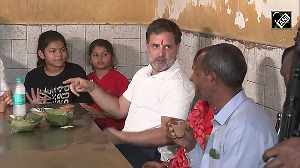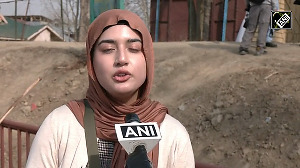For those who have personal experiences of a grotesque phenomenon called Naxalism, the assassination attempt on Andhra Pradesh Chief Minister N Chandrababu Naidu brought back unhappy memories. However, it is not merely the fact that the cult of murder draped in a red flag is still thriving which causes discomfiture.
Equally grim is the realisation that left-wing terrorism is still sought to be justified by sanctimonious invocations of its so-called socio-economic underpinnings. Extremist violence, noted the editorial in Times of India that could well have been a copy of a 30-year-old template, is an outcome of the distress faced by small and medium peasants, resulting in a disturbingly high rate of suicides.
It is an old formulation that is unfailingly repeated at convenient intervals. In those heady late sixties when it was a sign of fashion and intelligence to flaunt Chairman Mao's Red Book and proclaim China's chairman to be our chairman, we were informed that the roots of extremism lay in the inequalities of the Green Revolution. Countless seminar hours were expended in explaining the inevitability of the Green Revolution turning Red.
This mindless revolutionarary optimism was peppered by fantastic accounts of how China had banished poverty by applying Mao Zedong Thought to areas as unlikely as milk production and healthcare. Remember how the bogus China-watchers informed us of the everlasting glories of the Cultural Revolution?
In retrospect it all sounds rather peculiar. Yet, who can deny that a cream of Indian youth abandoned their homes and studies to make love and revolution.
Many of those who went underground did nothing more than reach Bihar, suffer from sleeplessness and dysentery, and rush right back to the embrace of forgiving families. Others ended up killing traffic policemen, murdering ageing vice chancellors, beheading statues of national icons and, finally, getting mixed up with the underworld.
There wasn't a hint of socio-economic deprivation to their rebellion. Their adventurism and treachery was entirely a function of ideological perversion, just as it is with those People's War Group cadres who planted the deadly claymore mines on the road to Tirupati. It comes as no real surprise that initial investigations point to the role of some middle class, human rights activists. It is also entirely predictable that the PWG leaders who have proudly owned up to the attempted assassination aren't unlettered adivasis groaning under the weight of feudal oppression, but hardened Marxist apparatchiks.
Let us not forget that it was Charu Mazumdar who inspired a despicable debate in the late sixties over the virtues of killing 'class enemies' with a knife rather than with a gun.
Yet, the myths are likely to persist. Forever in search of sociological explanations and historical analogies, the civil libertarians are likely to see this new Maoism as Indian variants of what the historian Eric Hobsbawm described as Primitive Rebels -- those who lacks a strategic understanding of revolutionary theory but are guided by blind anger at being left behind by capitalist development.
However, before policy is made on the strength of such incredible assumptions, certain facts need to be considered.
First, it is well known that groups like the PWG sustain themselves through straightforward extortion. The amount the Maoist groups levy by way of illegal taxes in the 'liberated' areas is said to total around Rs 40 crore, a sum that puts a different meaning to deprivation.
Second, far from being Robin Hood figures, the Maoists are pathologically opposed to development. Between 1990 and 2000, PWG violence led to the destruction of 748 buses, 183 telephone exchanges and property worth Rs 112 crore. The upholders of the cult of murder have a decisive stake in the perpetuation of poverty. Naxalites dont thrive in areas of capitalist development.
Third, the Maoist groups have forged links with each other via a Compact Revolutionary Zone stretching from Nepal to Maharashtra. They espouse different national struggles, a euphemism for championing the break-up of the Indian Union.
Finally, the entire Maoist movement is facilitated by human rights groups, who operate as the overground face of the underground. Their main political objective is to blunt the State response to terror. This dubious role of the civil liberties groups has been evident since the time of the Khalistani movement in Punjab.
Even after nearly 4,000 killings in 10 years, the war on Maoist terror has been inadequately robust. The Tirupati blasts are a wake-up call. The response to it must be sufficiently hard, indeed as hard as Siddhartha Shankar Ray's response to Charu Mazumdar's movement three decades ago.
We could, perhaps, begin by making life for Maoist activists underground or overground incredibly dangerous. Let us never forget that we are dealing with killers, even if they call themselves Maoists.






 © 2025
© 2025